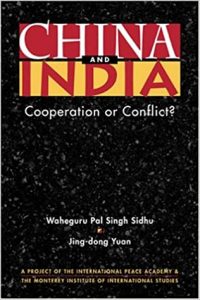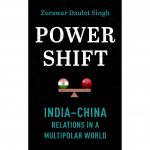
The book “China and India: Cooperation or Conflict” is a joint endeavour of an Indian
professor Waheguru Pal Singh Sidhu and a Chinese senior research associate Jing-dong
Yuan, which aims to study the intricate nature of the Sino-Indian bilateral relations. The book identifies and discusses the key variables that would shape this critical relationship, including changing threat perceptions and national security strategies in both countries; the undemarcated border and the status of Tibet and Sikkim; the complex China-Pakistan-India entanglement; the China-United States-India triangle and the weightage and influence of key domestic factors on decision making in both – India and China. Published in 2003, this study provides interesting perspectives from Delhi and Beijing on the ever-evolving Sino-Indian relations. In addition to analysing several primary materials for research from both countries, this book has also been put together through a large number of interviews of prominent Indian and Chinese scholars.
As mentioned in the book, the unwavering view of Sino-Indian relations found in the published reports of both countries tends to sway towards the more tempered opinions of analysts expressed in private interviews and conversations. But, what is the reality of the increasingly important security relationship between the two countries? The authors aim at addressing this very question in depth through this book.
In the introduction, the authors have explained the implications of India’s 1998 nuclear tests and what it meant with regards to the geostrategic backdrop of Asian security. It briefly states what the post-1998 environment would look like for the Sino-Indian relations and security relationship that would, in turn, affect their disputes over unresolved territories, their respective relationships with Pakistan, their arms control and non-proliferation policies and prospects for regional security in the years to come. It mentions that the relationship between the two Asian giants will go above and beyond just the regional sphere. In fact, there will be major effects on global arms control, great power competition and geostrategic realignment. The introduction also mentioned the threefold importance of the study conducted. The first one being – breaking off from the conventional lens of looking at Sino-Indian relations through the border issue, and instead focusing on the international, regional and domestic factors that would create the trajectory of their bilateral relations in the years to come.
Secondly, the authors wished to analyse the growing significance of Sino-Indian relations in the international arena. And finally, the role these two Asian giants would play in the management of nuclear and missile proliferation.
The book has tried to address the complex Sino-Indian relations by raising the following
relevant questions:
1. Given the acrimonious history of bilateral relations, will the evolving Sino-Indian
relationship be competitive or cooperative or a mixture of both? How will the emerging
relationship affect the regional and global power structures?
2. How and to what extent are regional issues, namely, India and China’s relationships
with Pakistan, and undeclared competition for influence and dominance likely to affect
future competition and cooperation between India and China?
3. What are the international factors that could influence patterns of competition and
cooperation between Beijing and New Delhi? They give particular attention to such
variables as the volatile Sino-U.S. relationship and the ongoing Indo-U.S strategic
dialogue and emerging partnership.
4. What has been the experience of China and India in the sphere of cooperative security?
To what extent will this experience determine the future course of relations between the
two Asian powers?
5. What are the domestic forces that could affect Chinese and Indian threat perceptions,
shape national security interests and priorities, and influence key policy decisions on
issues such as arms competition, arms control, and cooperative approaches to security,
including confidence-building?
The authors have attempted to discuss the above questions through six chapters very precisely without divulging unnecessary details.
Chapter 1 lays the historical background of the Sino-Indian relations and the factors that
have affected the progression of their bilateral relations such as territorial disputes,
ideological differences, the Pakistan factor and Tibet. It mentions the instances of postcolonial tensions from 1947-1962 leading up to the Sino-Indian war in 1962. The chapter then goes on to explain the cold-war situation that appeared between the two countries which eventually moulded into a period of rapprochement in 1979. The authors have also highlighted the implications of India’s 1998 Pokhran nuclear test on Sino-Indian relations. The chapter concludes by stating that although India and China have reached fairly better grounds, serious obstacles still remain in the way of the normalisation of relations. Additionally, in their opinion, the ‘détente’ is more of ‘conflict management’ rather than ‘conflict resolution.’
Chapter 2 deals with the threat perceptions of China and India, in the context of their
expanding power base – economic and military. It goes on to explain how their perceptions
of each other’s power dictate their policy towards one another. This chapter indicates that
among the many factors that make it difficult to establish any long term trustworthily
relationship between the two countries, the most impactful ones are – India’s nuclear weapon program, the continued distrust and animosity between Pakistan and India and in turn India’s deep concern over China’s regular nuclear and missile assistance to Pakistan. The authors have also explained the overlapping areas of geostrategic concerns of the two nations which are mainly Southern Asia and how they plan on navigating their policies in that domain.
Chapter 3, which according to me, is one of the most crucial and well-analysed parts of the
the book examines the U.S. factor in Sino-Indian relations. It discusses in detail how the United States influences the strategic calculations and policy options in both nations. A comparison of the Sino-U.S. and Indo-U.S. relationships is provided to understand whether these dynamics will eventually lead to potential cooperation or deepening competition between the two. It is noted that while both the countries aim to make optimum use of their bilateral relationship with the United States to improve their position on the world map, on the other hand, they also remain sensitive to each other’s intentions with the United States. And so, while an entente between the three could go a long way in promoting global peace and stability, it is also important that since the U.S. is the most sought after bilateral partner of India and China, it should refrain from playing one Asian power against the other for its short term gain.
In Chapter 4, the authors have presented an analysis of the Sino-Indian experience in the
field of cooperative security against the backdrop of the 1993 Agreement on the Maintenance of Peace and Tranquility along the Line of Actual Control in the India-China Border Areas and the 1996 Agreement on Confidence-Building Measures in the Military Field along the Line of Actual Control in the Sino-Indian Border Areas. This chapter explores the process of negotiations that led to both these agreements along with their effective implementation.
Lastly, Chapter 5 lays out the various pressure groups and individuals in both countries
that shape the trajectory of their foreign policy decisions. There is a detailed mention of the
domestic factors that influence the decision making processes. Accordingly, the People’s
Liberation Army in China and the defence and foreign policy community in India – impact
the policy options in important ways. Since the nature and composition of groups and
individuals is very different in both countries due to inherently different politico-military structures, their impact plays an extremely crucial role in deciding the future course of Sino-Indian relations.
Finally, in the concluding chapter, the authors have reviewed the previously mentioned
discussions and proposed a potential future trajectory of Sino-Indian relations.
Three possible scenarios have been stated which are as follows:
First, the two countries could be locked in an open competition for regional dominance as
they continue to expand their military and economic capabilities.
Second, China and India could come to cooperative terms and promote a multipolar world
where both of them play an important role.
Third, they could continue to look for solutions to their unresolved disputes as they
simultaneously explore areas of potential cooperation.
The book ends by proposing various options that would aid the promotion of cooperation over confrontation. All in all, this book explains in detail the exact complexities of the Sino-Indian relations from both sides, especially because it’s a joint endeavour of an Indian and a Chinese scholar. It is worth reading for those who are interested in studying the Sino-Indian relations from a holistic approach while keeping the geostrategic angle at the core.













